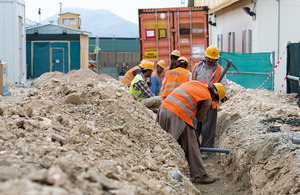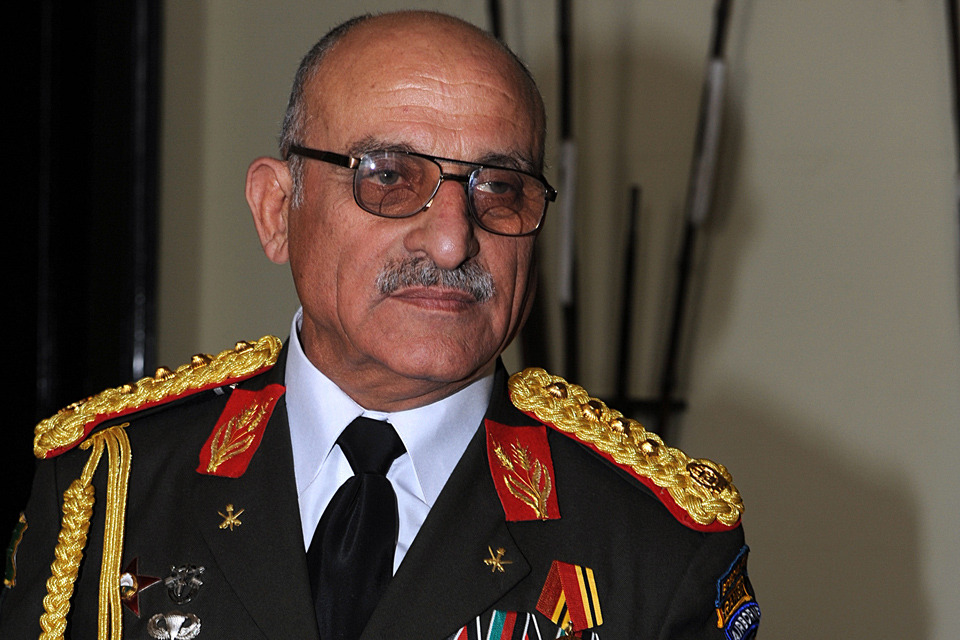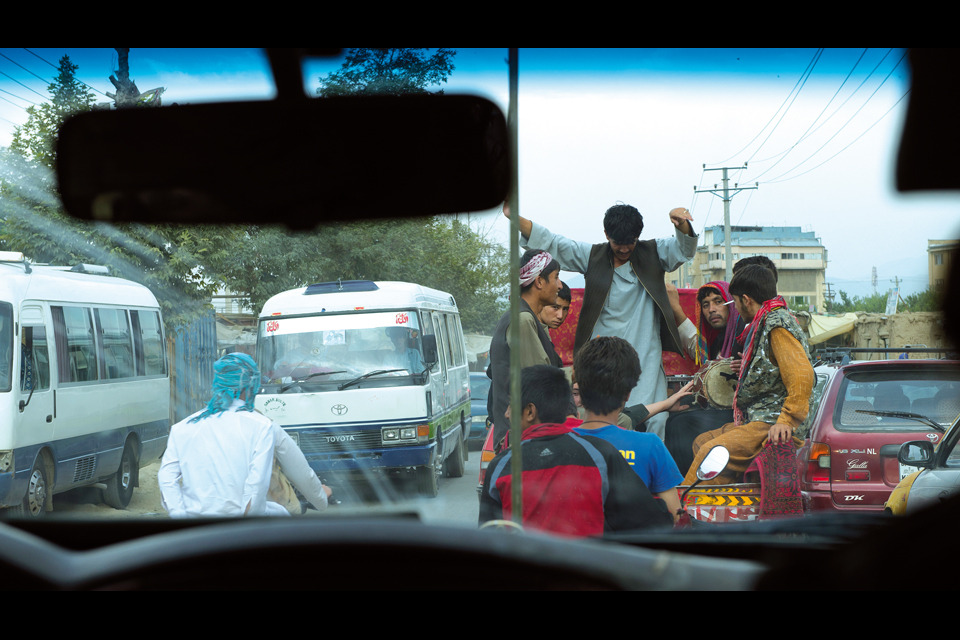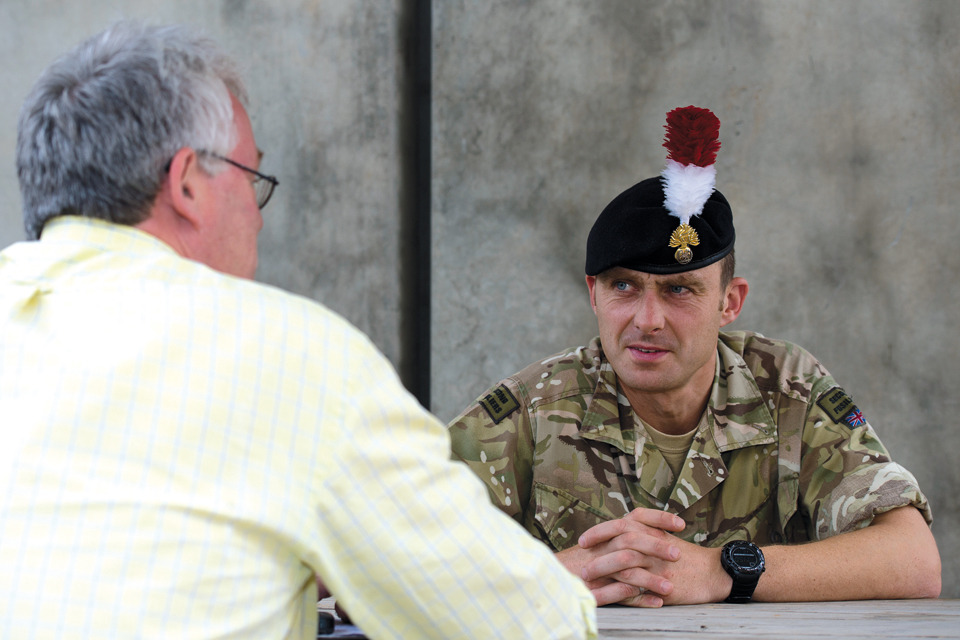Training Afghanistan's future military leaders
British soldiers are bringing the Sandhurst ethos to the Afghan National Army Officer Academy in Kabul. Report by Ian Carr.

Contractors building in the British support camp at the Afghan National Army Officer Academy, at Qharga [Picture: Corporal Jamie Peters, Crown copyright]
Summer in Kabul. A gunmetal grey sky threatens yet more rain, perhaps even another sudden hailstorm like the one that pounded the city yesterday. Although it is August, there are still patches of snow along the mountain range that forms the rim of the bowl in which Kabul sits. It is a dramatic landscape.
A meaningful place
We have come to Qargha, roughly 14km to the west of the city and 1,900 metres above sea level, to visit the Afghan National Army’s Officer Academy. As we drive up the track inside the 17.2-kilometre-long perimeter fence to a place where we can look down on the new build, we pass the wreckage of previous conflicts. Tangled Soviet tanks rust in heaps as testament to decades of fighting. Here, many great Afghan leaders have planned and fought foreign foes. With this military provenance, it seems right to build the academy here.
Qargha has tremendous historical significance for the Afghans,” said Lieutenant Colonel Grahame Hyland, the 1st Kandak Commander’s mentor.
There has always been an Afghan Army based here since before the Soviet invasion of 1979. It is a very meaningful place.
A Sandhurst General

General Sher Mohammad Karimi, the head of the Afghan National Army (library image) [Picture: Richard Watt, Crown copyright]
When the Government of the Islamic Republic of Afghanistan committed to building an academy to produce ethical and professional young warrior leaders, General Karimi, the Afghan Chief of the General Staff, became the driving force behind the project.
Being himself a product of the Royal Military Academy Sandhurst, the General needed no convincing that the famous British institution was the model they needed to follow to identify and develop their own talented young officers.
He likes the way the Brits go about their business,” said Colonel Hyland.
He appreciates the importance of the constant theme of leadership running throughout the 42-week course. He likes the way we use senior non-commissioned officers (NCOs) and warrant officers to instruct our young officers. He sees the benefit of that and how it will help them to become a more professional army to face the challenges of the future.
For more than a year the UK has led the NATO Training Mission to support the Afghan National Army to develop their academy. From establishing how they will identify and select potential officers for the course, to what the syllabus content will be and how the training will be delivered.
Afghan junior and senior officers and politicians have paid many visits to the UK to see for themselves why we have become internationally recognised in the field of army officer training.
Cultural relevance

Life in Kabul during a vehicle patrol back to Camp Souter from Qharga [Picture: Corporal Jamie Peters, Crown copyright]
Of course it is nice to be admired, but the purpose of these trips was to help the Afghans to develop their own kind of academy. To produce the quality junior leaders they needed in a way that would make sense to them using methods and examples that would be Afghan-led. Colonel Hyland offered an illustration of what this means:
For example, when the students are looking at defensive battles in the war studies part of the course, they will be learning about the Afghans’ defence of Herat. When it comes to studying the elements of attacking battles they could look at the Battle of Maiwand and identify what tactics their predecessors employed that helped them to annihilate us.
This, explains Colonel Hyland, is how Dr Duncan Anderson, a war studies expert from Sandhurst, is mentoring his own Afghan counterpart to teach the young officers. He continues:
Instead of looking at Wellington’s leadership qualities – what relevance has he to an Afghan cadet? They could look at Shah Massoud’s leadership credentials: How did he manage to hold the Panjshir Valley against the Russians? What better example can there be to set for junior officers?
Along the way, British troops have been mentoring their Afghan counterparts, advising them on manpower, selecting the best candidates, building up kit, developing the course and mastering the coaching and mentoring skills that they will need to teach it, and how they will assess the students.
On a personal level mentoring is a tricky thing to explain,” said Colonel Hyland. “It is unique to the person you are mentoring and to the mentors themselves.
For me it’s about making sure that the kandak commander understands the ramifications of every decision he makes. It’s about helping him to see the broader picture, not just the minutiae of delivering the first kandak through the academy but also how it is going to affect the Afghan Army in future. But it is also about humility and understanding that, just because you do something in a certain way, it isn’t necessarily the only way it can be done.
Choosing the best

Captain Aaron Florence talks with Ian Carr [Picture: Corporal Jamie Peters, Crown copyright]
Another academy mentor is Captain Aaron Florence. His tour has been all about bedding in the Afghan Army’s officer selection process to recruit the best intake of students for the academy. He said:
We trained the selectors up to the first board, which was on 22 June. Altogether there will be 22 selection boards, each of which is 3 days long. We will select 272 from 998 candidates.
It’s a revolutionary concept for the Afghans, but it is one that they have embraced. So how does this crucial stage work?
Candidates who want to become an officer go to an Afghan equivalent of a recruiting office, where they are sifted, checked against criminal records and biometrically tested. Those who pass through this filter are then sent to the academy to undergo the selection boards.
We put them through a number of tests,” said Captain Florence. “They have to complete an obstacle course, and a physical fitness test – press-ups, a mile-and-a-half run, sit-ups, as many as they can do in 2 minutes.
They also have to face a general knowledge test – answering questions such as, who was the first Afghan in space? Which countries border Afghanistan? And they are quizzed on simple current affairs. Other tests include a board interview, writing a short essay and delivering a short talk on something of their choosing – usually something about their village or their province. But because the point is to produce seed corn second lieutenants, a weighting is put on the importance of passing the physical.
Captain Florence said:
This academy is about producing young leaders. It’s no use if they are not physically capable of leading men into battle.
Performance over posh shirts
When the candidates arrive they are given a name and a number. For the next 48 hours this will be their identity. This is done to make as sure as possible that when the selectors make their judgements they are based on merit rather than on the possibility that it is a general’s son or daughter that is standing in front of them. A smart appearance is not one of the criteria that will necessarily sway the board. Performance rather than a posh shirt is what matters.
We do give advice on what sort of clothing candidates should bring, such as don’t forget your trainers for example,” said Captain Florence, “things that we might take for granted, but in fact some candidates just might not have things like that. We’ve had some guys that have come along with just the clothes they stand up in, and then they’ve done the physical test and smashed it. One guy, Red 3, I’ll always remember him, only had flip flops, so he ran his physical fitness test barefoot – and he came first.
Since the selections began, Captain Florence has been increasingly able to lift his hand off the tiller. At first he used to be there all the time, now he need only be there at the beginning of the day to make sure everything is running smoothly.
Training the trainers
Working with those who will be responsible for instilling the basic soldiering skills that a young officer needs to master has been Warrant Officer Peter Witkawski of 2nd Battalion The Royal Regiment of Fusiliers.

Warrant Officer Peter Witkawski talks with Ian Carr [Picture: Corporal Jamie Peters, Crown copyright]
As well as helping his opposite numbers work out how they are going to get the drills and skills inside the heads of their students, Warrant Officer Witkawski has had the tough job of developing the instructors’ skills. It is a challenge that has taken the British Army generations to perfect. No where else in the world will you find an NCO who can bark at a young officer and deliver the epithet “Sir” like a cosh to the back of the head. Warrant Officer Witkawski sees it as no joke:
It’s a very embryonic stage for them. Their NCO-equivalents are not held in the same regard as in our structure.
If I say something I tend to be listened to; our structures in the British Army are set up that way. There is an emphasis on the NCO providing the officer cadet with instruction. The Afghan officer corps has to learn to hand over that responsibility. It’s a big ask.
When at full strength, each intake will have 350 students. But, for the first 2, there will be just 270 to allow room to develop the course and manage any initial teething troubles. By September next year each intake will also have a cadre of 90 females. As the date for the first course nears the team are hoping for good weather.
We were lucky this winter, it was quite mild. But we can get snow here from November through to March. Inevitably that would have an impact on the training,” said Colonel Hyland. “But we’ll cope, they’ll still be able to train because they will be issued the kit they need.
Good news indeed for candidate Red 3.